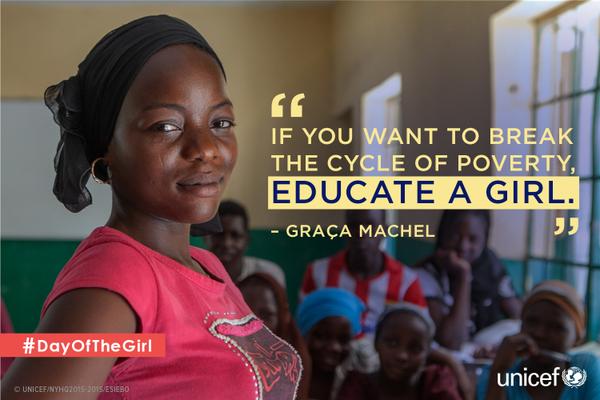
October 10, 2015
By Suzanne York
Of all the important designated days throughout the year intended to raise awareness on specific issues, one of the most important is the International Day of the Girl Child (October 11).
Investing in and empowering girls is not only the right thing to do, it has a positive impact on the world, which can extend far beyond a single girl.
International Day of the Girl Child is a day designated by the United Nations to recognize girls’ rights and issues concerning gender inequality that many confront daily around the world. This year’s theme focuses on the unique importance of investing in adolescent girls. The world now has the largest generation of girls in history – there are nearly 600 million girls aged 10 to 19.
Overcoming Challenges Faced by Girls
According to UN Women, even though the lives of many girls are steadily improving, “many are still subjected to horrific practices, such as female genital mutilation, son preference – often resulting in female infanticide – as well as child marriage, sexual exploitation and abuse. Girls are also more likely to experience discrimination in food allocation and healthcare, and are often outpaced and outranked by boys in all spheres of life.”
It is easy to fall into the trap of thinking the problems are insurmountable. But the stories of overcoming the odds and making girl’s rights a priority are increasing everywhere. This is especially true for greater access to education.
Malala Yousafzai, the young Pakistani shot by the Taliban for speaking out for the right of girls to go to school, has become the face of the movement. And if this 18-year-old’s story hasn’t been incredible enough, she already has a published biography, documentary film, and has won the Nobel Peace Prize.
Malala is a passionate advocate for education for both girls and boys and the teenager is calling on world governments to provide every child with free education. Her message is simple. “Education is the best way we can fight all the problems we’re discussing now.”
Nepal: Changing the Narrative
A big factor preventing some girls from getting an education is child marriage. One reason that girls are married off at a young age is due to poverty. Oftentimes, a family cannot afford to feed another child (much less educate, especially a girl), so marriage is a way to reduce the burden on poor families.
The UN states that one in nine girls is married by age 15. By 2020, one in three girls in developing countries will be married by age 18, or 142 million girls.
Traditions like child marriage deny girls their rights to health, education and opportunity; it also puts them at greater risk of domestic and sexual violence.
Fortunately, cultures can and do change. But that change must predominantly come from within, from an existing understanding of culture, tradition and religion, and it must involve men and women.
The organization Girls Not Brides notes that in Nepal, child marriage is closely linked with traditions of certain ethnic and religious communities. The South Asian country has one of the highest rates of child marriage in the world, with 41% of girls married before the age of 18.
Population Media Center, known for its work producing programs on radio and television that address health and human rights in many countries around the world, recently announced the launch of a Nepali-language drama program. It will address child marriage and other related issues of early pregnancy, maternal health, reproductive rights, girls’ secondary education, and sexual violence against both women and girls.
There will even be a hosted call-in radio talk show after the programs air. PMC believes that “Together, these radio programs will stimulate positive community discussions on the topic of child marriage and its negative effects on the children, as well as drive measurable changes to the behaviors that perpetuate the harmful traditional practice.”
Girls: A Smart Investment
There is still much work to be done to elevate the rights of girls. But growing awareness of the needs of the girl child is changing the situation for the better. When girls are empowered with basic human rights such as education, healthcare, and reproductive rights, they will be able to create a better future for themselves.
The International Day of the Girl is just one day out of the year, but with greater support it can make more days better for girls in every nation and every walk of life, which in turn will help create a healthier global society.
[photo credits: www.unicef.org]

There are many ways to participate! Together, we can raise awareness and bring about change.